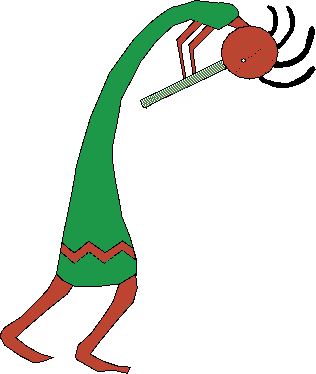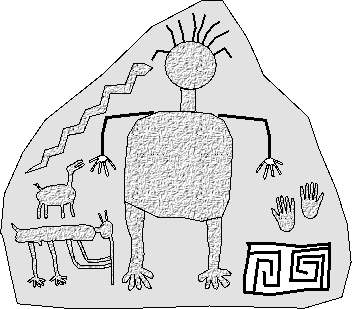

.
The outline of the frontispiece Kokopelli is based on an
authentic design, described below. The colors depicted are a
fanciful creation by the author, designed for effectiveness on
the computer screen, not for scientific accuracy.
The frontispiece design is based on a Hohokam cultural
interpretation of Kokopelli. The Hohokam were contemporaries of
the Anasazi who resided in an area of the south-central river
valleys of Arizona, topographically below the Mogollon Rim. The
most-commonly reproduced version of this figure is based on a
pottery bowl found near Snaketown, Arizona, southeast of Phoenix.
A sketch version of the pottery design is shown in Grant (p. 61)
and in Young (front and back covers and page 1). On the bowl,
Kokopelli is shown with his wife, Kokopelli-mana. The Hohokam
depiction of Kokopelli shows significant curvature of the spine,
but little evidence of a large hump.
A variation on the style shows a similar Hohokam Kokopelli with a cane, as a "Cane Dancer" (see
Slifer and Duffield, p. 32).
Southwest Sun Fabrics, of Columbus, NM, (e-mail address?) has used a variation of the design as
a fabric pattern and as one of many Kokopellis on a screenprinted tee-shirt (Young, pp. 2 and 5).
Young's reproductions are in black and white, although Southwest Sun may have used color for
their designs.
Close observation of the various "reproductions" of the ceramic bowl design show the danger of
relying on sketches for details. Almost every copy of the bowl Kokopelli shows significant
variations in the proportions of the arms and legs, and especially in the way the hair (or feather
headdress?) is reproduced or drawn. The shoulder/chest area also varies in detail from copy to
copy. Variations in line weight can produce some of the apparent differences, but not all.
Slifer and Duffield's Figure 185 (p. 114) may be a photograph of the actual bowl, involved. If so,
it shows how innacurate sketches can be. There are so many differences between the pattern in
the photograph and the variations of the sketch design that it strongly suggests that Figure 185 is a
photograph of a different Hohokam bowl. Slifer and Duffield specifically mention how unusual it
is that the bowl design in Figure 185 is random and asymmetrical. The sketches all depict a
highly symmetrical pattern, as is normally seen in Hohokam art.
The representation on these pages is not intended to be a direct copy of any of these
interpretations, since they vary so much. The outline, only, of the figure is based on the general
outline and proportions shown on the bowl design.

The outline has been modified to add internal details,
clothing, and, for the large version, color. The colors were
selected for accurate reproduction on both PCs and MACs, not for
their relationship to common pigments, easily available in the
ancient Southwest. A smaller, gray version, was also prepared,
as shown above.
As interpreted in these versions, Kokopelli is all gussied up for a ceremonial event, wearing a "dress." This was not necessarily the intent of the Hohokam. A naked upper torso, with a loincloth wrap is an equally valid interpretation of the black outline figure on the bowl.
.


.
The basic Kokopelli figure that does all the heavy labor on these pages is primarily based on sketches by Oswald White Bear Fredericks in Frank Waters' Book of the Hopi. Frank Waters lived with White Bear below Pumpkin Seed Point while conducting his research and writing. White Bear, a full-blooded Coyote clan Hopi from Oraibi, was a tremendous help on the project, making sketches of relevant rock art around the Southwest and Meso America, as well as recording and translating the contributions of numerous Hopi elders and cultural/religious leaders.

The flute-player image on these pages resembles most closely White Bear's copies of rock art figures at Oraibi, Chaco Canyon, and Gila Bend, as shown in Figure 48, p. 105. Petroglyphs at Canyon de Chelly and in the state of Sonora, Mexico, are similar, but recumbant, with resting legs, indicating a sojourn in those areas.

Heather L. Hamilton has redrawn White Bear's sketches of original petroglyphs for John V.
Young's book on Kokopelli (pp. iii, v, and vii).
With so many second and third generation versions of rock art apperaing in the references, it is
emphasized that the images on these pages do not claim to be scientifically "authentic."
Kokopelli has long been known as a Jack of all trades. Thus he has been put to work on these Web pages.
.

Digger Kokopelli is a construction worker, running around, laying the foundation for new pages. He is also a scientist, a researcher, digging up new information for inclusion on the site.
.

Scholar Kokopelli strolls around, wearing his mortarboard,
going to the Suggested Reading Rock

or to Library Rock

He keeps abreast of things by checking out the latest e-glyphs.
He enjoys reading and putting facts together.
.

Kokopelli does his work on his computer at his hogan, keeping the hogan page up to date.
.

Messenger Kokopelli keeps things up to date, delivering the e-glyphs from place to hogan via moccasin telegraph.
.

Printer Kokopelli grabs those pesky electrons and taps out
e-glyphs for the readers convenience.

.
 Proceed to the Construction Zone
Proceed to the Construction Zone
 Follow scholar Kokopelli to the Suggested
Reading List
Follow scholar Kokopelli to the Suggested
Reading List

 Go back to The Illustrations and Images
Go back to The Illustrations and Images
 Return with Kokopelli to the hogan page, the
Table of Contents
Return with Kokopelli to the hogan page, the
Table of Contents
.

Black Mesa Highlighted in Sunlight on a Stormy Day
.
 to
treeves@ionet.net
to
treeves@ionet.net
.

.
Contents, including illustrations, copyright © T. K. Reeves, 1997.
 on 20 April, 1997.
on 20 April, 1997.